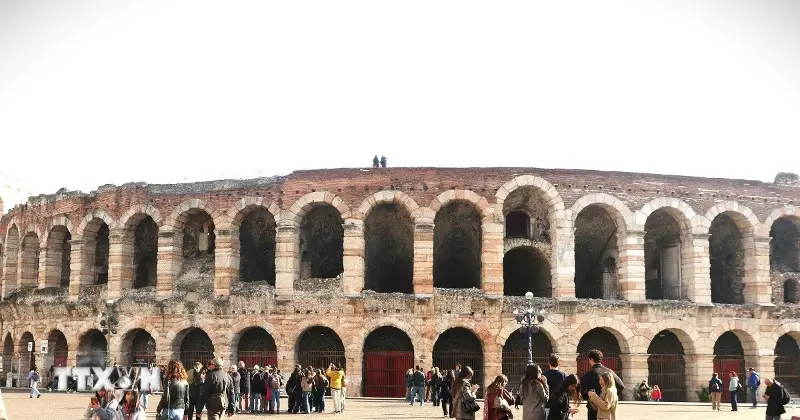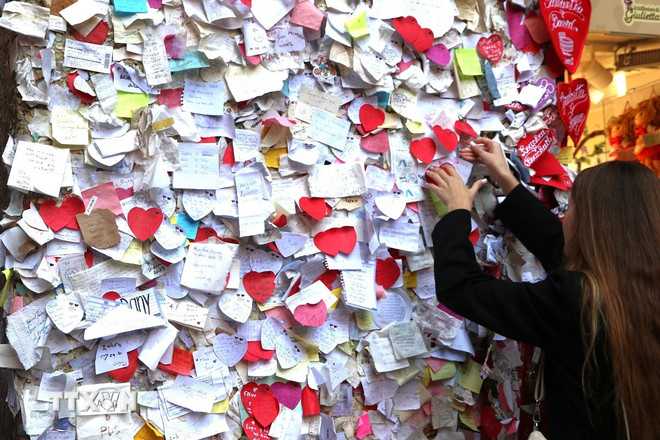Verona boasts a unique blend of ancient Roman architecture, splendid Renaissance squares and the atmosphere of eternal love that Shakespeare portrayed.

According to a VNA reporter in Italy, Verona - the city of love associated with the love story of Romeo and Juliet located in the beautiful Veneto region, Northern Italy, has long been a famous tourist destination, attracting millions of visitors each year because of its ancient, romantic beauty and legendary historical stories.
Lying along the gentle Adige River, between two great cultural centers, Milan and Venice, Verona possesses a unique blend of ancient Roman architecture, splendid Renaissance squares and the atmosphere of eternal love that the great Shakespeare portrayed.
When coming to the city of Verona, visitors will be immersed in an enchanting space, where every street corner and every architectural work tells a story. From the majestic Roman arena, the poetic house of Juliet, to the bustling squares and ancient churches.
The history of the city of Verona is closely linked to the Della Scala (Scaligers) – the family that brought Verona to the height of power in the 13th-14th centuries. Afterwards, Verona became part of the Republic of Venice for 4 centuries, until it was occupied by Napoleon and ceded to the Austrians in 1797.
The city's two-thousand-year history is evident in the magnificent Arena di Verona in Piazza Bra, one of the largest ancient Roman structures in the world still in use.
Built in the first century AD to host gladiator fights and many public events during the Roman period, by 1913 it had become the world's largest open-air opera house with the classic Aida by the "father of opera" Giuseppe Verdi.

Today, the Roman Arena is famous for its spectacular opera performances in the summer, attracting thousands of visitors to enjoy the ancient and attractive space.
With a capacity of up to 30,000 people, the arena still retains its grandeur and historical setting. Here, we can explore the giant structure, admire the ancient Roman architecture and deeply feel the atmosphere of the monumental events of the past. This arena is not only an important historical relic but also a world-class cultural and artistic destination.
Verona is also the setting for Shakespeare's classic work "Romeo and Juliet", with Juliet's house, built in the 12th century with its famous balcony, which witnessed the romantic love story of the young lovers forbidden by both families.
Inside the house are many artifacts that recreate that period. A bronze statue of Juliet is also located in the yard, where many people can come and touch the statue's hand to pray for luck in love.
This is a tradition followed by many couples and people looking for love. When they come here, visitors often leave love notes on the walls around the house.
The romance and legend associated with this house have made it an unmissable stop when visiting the city of Verona.
In addition to the Roman Forum, located in the heart of the city's historic center and Juliet's home, Verona also has many historical monuments such as Giardino Gusti, a garden with mysterious and fascinating caves and mazes, Piazza delle Erbe, an old Roman square, today a lovely outdoor market, the Lamberti Tower, where you can climb the tower to see the whole city of Verona, a number of churches and cathedrals, notably San Zeno Maggiore, and the ancient castle of Castelvecchio.
Speaking to VNA reporters, Mr. Oreste Vernarelli said: “Verona is a city not only famous for the love story of Romeo and Juliet, but also a city of beautiful universities; historical stories, as well as having a mayor Damiano Tommasi who is a former professional football player of Roma. In this city, there are many activities for both tourists and locals. The roads and the city are very well connected, the infrastructure and everything is developing rapidly. In addition, Verona is located in the center of the Veneto region, so it is connected to all important cities and places such as Lake Garda, Venice, Padova. I like this city very much and have been here many times.”
With its unique urban structure and architecture – combining ancient Roman relics with the influence of Renaissance art, Verona has been recognized as a World Heritage Site by the United Nations Educational, Scientific and Cultural Organization (UNESCO) since 2000./.
